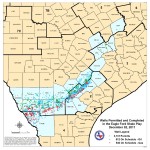Report: As Drilling Grows, Fracking Using More Water
From The Texas Tribune:

Photo by Matthew Lloyd/Getty Images
Engineers on the drilling platform of the Cuadrilla shale fracking facility on October 7, 2012 in Preston, England.
A new University of Texas at Austin study has found that the amount of water used in the drilling practice known as hydraulic fracturing has risen sharply in recent years as oil and natural gas production has surged.
But the 97-page study, funded by the Texas Oil and Gas Association, also found that the amount of water used in hydraulic fracturing would level off sometime in the decade starting in 2020, as water recycling technologies matured and the industry’s rapid growth rate cooled.
Hydraulic fracturing, or fracking, is a water-intensive practice in which liquids are pumped underground at high pressure to retrieve oil or gas trapped in rocks, like shale.
The Texas Water Development Board circulated the study last week to regional water planning groups around the state. Those groups are preparing the state’s next water plan, due out in 2017.
The study is an update to a 2011 study that was prepared by UT-Austin’s Bureau of Economic Geology using funding from the Water Development Board. This study was also prepared by UT-Austin’s Bureau of Economic Geology, but it was funded by the oil and gas association. It is considerably shorter than the earlier study (97 pages vs. 357 pages), but it is more narrowly focused on oil and gas. (The earlier report did further analysis of other water-intensive activities in the mining sector, like coal mining.)
Dan Hardin, the Water Development Board official who circulated the study to regional water-planning groups, said that the board had not funded the updated study because of financial constraints. “Because of our budgetary situation, we did not have the funds available to commit to it at the time,” he said. However, the board agreed with the methodology of the study, he said.
Jean-Philippe Nicot, a research scientist with the Bureau of Economic Geology who served as the lead author of the study, said that oil and gas association funding had not constrained his work. In fact, he said, it had resulted in better industry cooperation than the 2011 study, which he had also worked on.
“I must say, they let me do my work, no problem,” he said.
The new study (which cost $95,000, according to the oil and gas association) “doesn’t change the high-level picture” of the use of water for fracking, according to Nicot. It found that total water use for fracking in Texas rose by about 125 percent, from 36,000 acre-feet in 2008 to about 81,500 acre-feet in 2011. (For comparison, the city of Austin used about 107,000 acre-feet of water in 2011.), About one-fifth of the current total comes from recycled or brackish water, a category that has been growing.
“We are using more and more brackish water, and reuse or recycled water, and we think that is all positive,” said CJ Tredway, a consultant with the oil and gas association on water issues.
Nicot said that using brackish or recycled water was more expensive for the industry, but in some dry areas drillers had no choice.
In the Permian Basin, for example, “there is not much fresh water,” he said. “There is a lot of brackish water.” The study found that about one-third of the water used in fracking in the Midland area was brackish.
The total amount of water used in fracking in Texas is expected to level off in the 2020 decade at about 125,000 acre-feet, per year, the report states. Nicot predicted that water-recycling technologies pioneered in the Pennsylvania drilling area known as the Marcellus Shale would become more cost-effective and then make their way to Texas.
Oil and gas account for less than 1 percent of the state’s total water use, according to the report. Hardin of the Water Development Board agrees with that figure, though usage for the mining sector as a whole [which includes coal and other types of mining] is 1 percent to 2 percent, he said.
However, water use for fracking in drilling-intensive rural counties can be high. The 2011 study mentioned that in Dimmit, Webb and LaSalle counties — all in the Eagle Ford Shale — more than 50 percent of total water use comes from the broad category of mining. (Mining would mostly consist of hydraulic fracturing, in this instance.) The current study did not contain such estimates, though clearly water usage in heavily drilled counties remains significant.
Cyrus Reed, acting director of the Lone Star Chapter of the Sierra Club, said that high water use by the oil and gas industry in West and South Texas remained a concern. He said he viewed the report as a useful planning document, but more study needed to be done.
“While Sierra Club believes this more accurate look at oil and gas water use, based in large part on actual water use from an industry database and interviews with individual companies, is a great first step, we continue to support a more robust requirement that the Railroad Commission [which regulates oil and gas in Texas] both collect and aggregate water use data for the regional water planning process,” he said in an email.
Nicot said that given the fast-changing nature of technology and the resurgence of drilling, he hoped to continue doing updated studies.
“I think we need to do an update fairly frequently, at least every other year, because the industry is evolving very fast,” he said.

